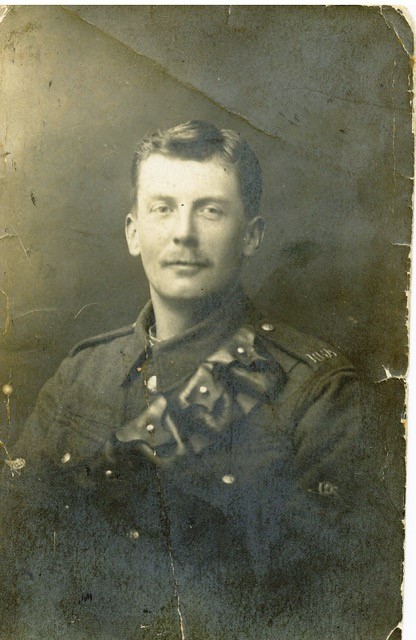
Submitted by Ron Taylor, “raised in Shute Road Catterick Camp, moved to Scotton and was schooled in Richmond before wandering around with the forces”……who wanted to tell us about his grandfather, Percy.
Percy was born about 1891 in Brighton Sussex, and died 20 September 1967 aged 76.
68703 Bdr Percy Levi Lelliott, enlisted in the 119th Siege Battery, Royal Garrison Artillery, Sussex on 12 Dec 1915. He undertook initial training at Shorncliffe. His unit embarked for France on 5 June 1916, and he fought at the Battle of the Somme. Percy distinguished himself in the field on several occasions by bringing in wounded men under heavy gunfire, sometimes dragging them by his teeth. He was subsequently awarded the DCM. Discharged as Sgt (Acting BSM) 13 February 1919.
Percy retired in 1946 after a long career in the Police Force. PC Lelliott received four Commendations from the Watch Committee and local magistrates, two of which referred to rescue operations at Fairlight and Ecclesbourne Cliffs. Retired, Grandpa Percy sat in his Windsor Chair, smoked his pipe and tended his greenhouse.

Percy Lelliott’s Distinguished Conduct Medal citation

His medal card
Explore more memories from the ribbon
-
Walter G Barker
Walter Gorner Barker was born in Richmond on 2 August 1889. For a time he lived with his family at 71 Frenchgate. He worked as a footman for Sir Mark Sykes at the family seat, Sledmere House near Driffield. Sykes was Commanding Officer of the 5th (Territorial) Battalion of the Yorkshire Regiment before the war. It seems that Walter may have served as a territorial soldier before the war (he has a low early regimental number 2274 which is then revised later to 240643). He enlisted at Scarborough and became a Private in the 5th battalion. Walter died on 27 May 1918, south of Craonnne. Prior to this, the battalion war diary records several days as ‘day quiet in trenches’ before the ominous entry for 26th May – ‘”Stood to” at night owing to information received that enemy attack was to be delivered on morning of 27th May’. The diary records that the bombardment began at 1 am with the enemy attacking at 4.30am. The battle lasted for four days. Walter Gorner Barker is commemorated on the Soissons Memorial in France.
-
Cpl W G Padden
Anthea Dunne dropped into the museum with a photo of her father (pictured in the centre of the group), and after a little research she has managed to piece together the story of his service during the First World War. William George Samuel Padden was my father from Pontnewydd, near Newport, Monmouthshire, he volunteered and enlisted at Carmarthen in west Wales on 9th October 1914, as part of The Pembrokeshire Yeomanry, the Territorial Force. As a Private in the Pembroke Yeomanry, he was given the regimental number 4390. Although not compelled to, he signed up as willing to serve overseas. He was transfered to 210 Company of the Machine Gun Corps (part of the 4th Dismounted Brigade) on 22nd October 1916 and given the new regimental number 74792. Initially a private in the Machine Gun Corps, he later became a corporal (29th May 1918). In April 1916 he sailed for Alexandria as part of the 4th Dismounted Brigade, fought in Egypt, stationed at Wadi El Natrun for 2 years. By 1917 this brigade had become part of The Welsh Regiment. By May 1918 he was fighting on the Western front in France. He was wounded on September 25th 1918 and sent home to a military hospital in Reading with a fractured right femur. He was finally discharged from hospital on May 3rd 1919 with a 40% degree of disablement and a pension of 12 shillings a week [with a temporary bonus of 20%]. He received a Silver War Badge in…
-
John Albert Lancaster
Submitted by Glennis Robson. John Albert Lancaster was my uncle, he was my mother’s elder brother (13 years older). My mother spoke of much loved brother who was a source of goodness and “spoilt” his baby sister. On receiving the news of his death my grandmother picked my mother up from school. They made their way home down the back lanes to hide their tears from passers by. “Jack”,as he was known, was killed on the 16th of October 1917 at hill 60 in Flanders aged 19 after only a few months at the front. He enlisted in the Duke of Wellington’s (West Riding) regiment on the 6th of December 1916 in Newcastle. His father William, a farrier, also joined up declaring that if his son was prepared to fight so was he. Unlike his son he survived the war. Having no known grave his name is on the Menin Gate. In 1988 my husband Keith and I visited the Western Front to see his name and the battlefield where he died. Since then “our Jack” has been in the consciousness of the wider family. Every November we place a poppy cross by my mother’s grave-stone in St Mary’s churchyard.
